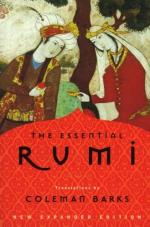
|
| Name: _________________________ | Period: ___________________ |
This test consists of 15 multiple choice questions and 5 short answer questions.
Multiple Choice Questions
1. Rumi uses the metaphor of a string between two animals to represent what?
(a) Confusion.
(b) Imprisonment.
(c) Secret connections.
(d) Selective hearing.
2. Are Rumi's friends mentioned directly in his poems?
(a) Only in some.
(b) No, in none of them.
(c) Yes, in all of them.
(d) It is impossible to tell.
3. Before responding to the king's command in a poem in Book 1, Chapter 3, what does Ayaz do?
(a) Consults with the King's daughter.
(b) Prays to God for guidance.
(c) Notices how at least thirty other men respond to the command.
(d) Reads at least forty books to learn how others handled the situation.
4. The purpose of Coleman Barks' preambles to Rumi's poems is to:
(a) Add a new twist to the message of each poem.
(b) Help the reader interpret each poem.
(c) Expand upon Barks' discomfort with each.
(d) Get the reader to come up with his or her own judgments.
5. In the story of a camel and a mouse found in Book 1, Chapter 3, what does the camel do when the two reach a body of water?
(a) Takes a bath.
(b) Runs away.
(c) Encourages the mouse to continue.
(d) Tosses the mouse into the water.
6. Rumi's works are deeply:
(a) Sorrowful.
(b) Humorous.
(c) Irreverent.
(d) Emotional.
7. Who is Coleman Barks?
(a) Satirist.
(b) Photographer.
(c) Scholar.
(d) Psychologist.
8. Most of Rumi's poems presented in this book exhibit what form?
(a) Rhyming verse.
(b) Formal repeating pattern.
(c) Strict syllable counts.
(d) Light free verse.
9. In a poem entitled "Rough Metaphors," Rumi asserts that a lover's reverence is often sheltered in:
(a) Love.
(b) Complacency.
(c) Comfort.
(d) Secrecy.
10. In a poem in Book 1, Chapter 2, several men invade a city because they are driven by what?
(a) Their egos.
(b) A mad dictator.
(c) Sexual attraction.
(d) Greed and hate.
11. Much of Rumi's poetry is:
(a) Cryptic.
(b) Passionate.
(c) Subdued.
(d) Sarcastic.
12. In this book, the term "nafs" refers to what?
(a) The part of the soul associated with desires.
(b) The highest state of enlightenment.
(c) A food commonly consumed during Rumi's time.
(d) A style of poetry developed by Rumi.
13. One of the key attributes of the character Ayaz is what?
(a) Arrogance.
(b) Loyalty.
(c) A tendency to lie.
(d) A fear of nearly everything.
14. In a poem in Book 1, Chapter 3 about Ayaz the courtier, what command does the king give?
(a) To make him laugh.
(b) To repair a damaged piece of furniture.
(c) To destroy a precious object.
(d) To bring him the costliest treasure.
15. In Rumi's string metaphor, the string connects two animals by their what?
(a) Necks.
(b) Ankles.
(c) Wrists.
(d) Ears.
Short Answer Questions
1. The poem in Book 1, Chapter 2 about a man who accidentally soils himself includes lessons on which of the following?
2. How many years did it take Coleman Barks to truly comprehend Shams Tabriz through Rumi's poetry?
3. In the poem in Book 1, Chapter 2, where several men fall in love with the same woman, her physical beauty is really a representation of what?
4. Over time, what has Coleman Barks been able to do with Rumi's poems?
5. When speaking of sugar and vinegar, Rumi notes that a spoonful of vinegar:
|
This section contains 541 words (approx. 2 pages at 300 words per page) |

|




